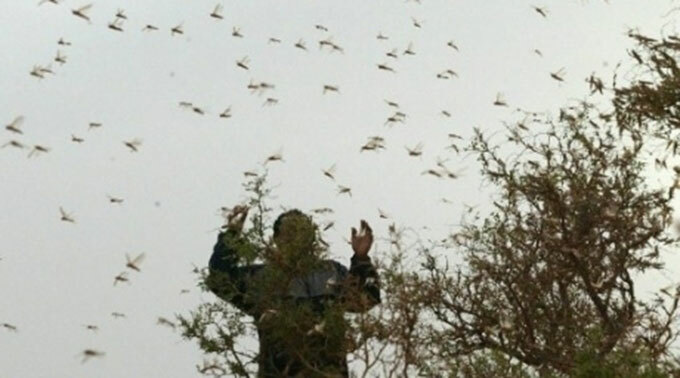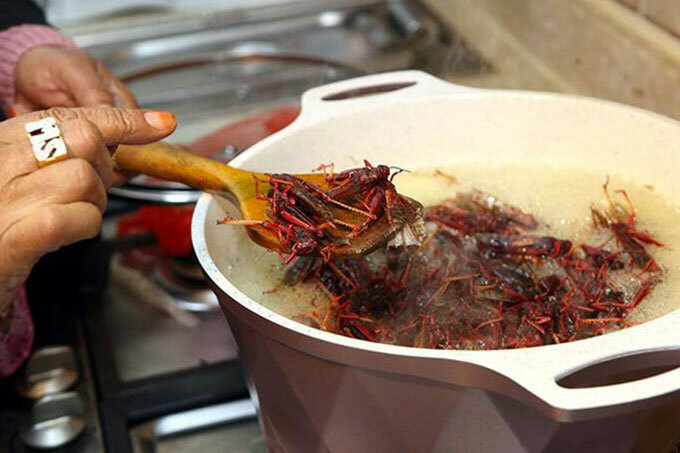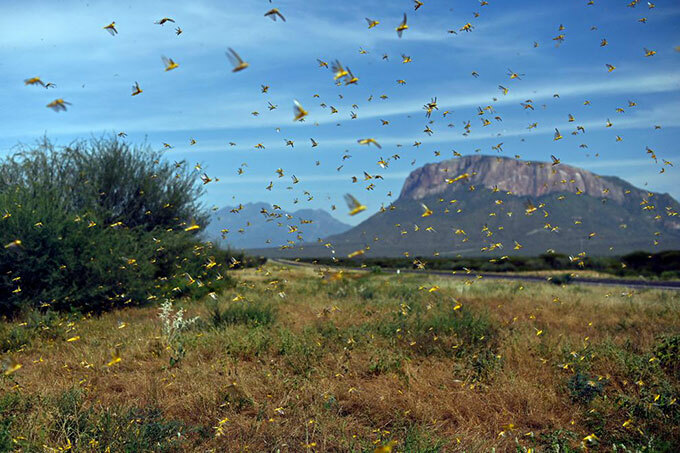Common questions about locusts
Feb 10, 2020
Desert Locusts are usually restricted to the semi-arid and arid deserts of Africa, the Near East and South-West Asia that receive less than 200 mm of rain annually.

What is the difference between locusts and grasshoppers?
Locusts are part of a large group of insects commonly called grasshoppers which have big hind legs for jumping. Locusts belong to the family called Acrididae. Locusts differ from grasshoppers in that they have the ability to change their behaviour and habits and can migrate over large distances.
What is a Desert Locust?
The Desert Locust is one of about a dozen species of short-horned grasshoppers (Acridoidea) that are known to change their behavior and form swarms of adults or bands of hoppers (wingless nymphs). The swarms that form can be dense and highly mobile. The Latin name for Desert Locust is Schistocerca gregaria (Forskal).
What countries are affected by the Desert Locust?
During quiet periods (known as recessions) Desert Locusts are usually restricted to the semi-arid and arid deserts of Africa, the Near East and South-West Asia that receive less than 200 mm of rain annually. This is an area of about 16 million square kilometres, consisting of about 30 countries.
During plagues, Desert Locusts may spread over an enormous area of some 29 million square kilometres, extending over or into parts of 60 countries. This is more than 20% of the total land surface of the world. During plagues, the Desert Locust has the potential to damage the livelihood of a tenth of the world's population.
 One especially large swarm in northeastern Kenya measured 60 kilometers long by 40 kilometers wide (37 miles long by 25 miles wide). (AFP)
One especially large swarm in northeastern Kenya measured 60 kilometers long by 40 kilometers wide (37 miles long by 25 miles wide). (AFP)
Do Desert Locust plagues occur with any regularity?
There is no evidence that Desert Locust plagues occur after a specific number of years. Instead, plagues develop intermittently. Plagues of locusts have been reported since the Pharaonic times in ancient Egypt. During this century, Desert Locust plagues occurred in 1926-1934, 1940-1948, 1949-1963, 1967-1969 and 1986-1989.
How long does a Desert Locust live?
A Desert Locust lives a total of about three to five months although this is extremely variable and depends mostly on weather and ecological conditions.
The life cycle comprises three stages: egg, hopper and adult. Eggs hatch in about two weeks (the range is 10-65 days), hoppers develop in five to six stages over a period of about 30-40 days, and adults mature in about three weeks to nine months but more frequently from two to four months.
How many eggs does a Desert Locust female produce?
Desert Locust females lay eggs in an egg pod primarily in sandy soils at a depth of 10-15 centimetres below the surface.
A solitary female lays about 95-158 eggs whereas a gregarious female lays usually less than 80 eggs in an egg pod. Females can lay at least three times in their lifetime usually at intervals of about 6-11 days. Up to 1,000 egg pods have been found in one square metre.
How far and how fast can Desert Locusts migrate?
Desert Locusts usually fly with the wind at a speed of about 16-19 km/h depending on the wind. Swarms can travel about 5-130 km or more in a day. Locusts can stay in the air for long periods of time.
For example, locusts regularly cross the Red Sea, a distance of 300 km. In the past there have been some spectacular and very long distance swarm migrations, for example from North-West Africa to the British Isles in 1954 and from West Africa to the Caribbean, a distance of 5,000 km in about ten days in 1988.
Solitary Desert Locust adults usually fly at night whereas gregarious adults (swarms) fly during the day.
 Swarms of locusts originating from the winter breeding areas on the Red Sea coastal plains and subcoastal areas in northeast Sudan and southeast Egypt, threaten Egyptian crops (AFP Photo)
Swarms of locusts originating from the winter breeding areas on the Red Sea coastal plains and subcoastal areas in northeast Sudan and southeast Egypt, threaten Egyptian crops (AFP Photo)
How big are swarms and how many locusts are there in a swarm?
Locust swarms can vary from less than one square kilometre to several hundred square kilometres. There can be at least 40 million and sometimes as many as 80 million locust adults in each square kilometre of swarm.
What percentage of the Desert Locust's exoskeleton is chitin?
Chitin is the most important constituent of the cuticle or exoskeleton of the Desert Locust. The production of chitin is a continuous process and increases throughout the life of a Desert Locust, varying from about 1.7% (of fresh weight of a locust) during the hopper stage to 2.2% in the young adult and 4% in a two month old adult.
How much food can a Desert Locust eat?
A Desert Locust adult can consume roughly its own weight in fresh food per day, that is about two grams every day.
A 1 km2 size swarm contains about 40 million locusts, which eat the same amount of food in one day as about 35,000 people, 20 camels or 6 elephants. This is based on a person eating an average of 2.3 kg of food per day, according to the USDA.
A swarm the size of Niamey (Niger) or Bamako (Mali) eats the same amount of food in one day as half the respective country.
A swarm the size of Paris eats the same amount of food in one day as half the population of France; the size of New York City eats in one day the same as everyone in New York, Pennsylvania and New Jersey; the size of San Francisco eats the same has half of California; the size of Sydney (Australia) eats the same amount of food in one day as Australia eats in 1.5 hours.
What is the relationship between locusts and ecology?
When conditions are favourable for reproduction, locust numbers increase and when they are not, numbers decrease either by natural mortality or through migration.
For the Desert Locust, favourable conditions for breeding are (1) moist sandy or sand/clay soil to depths of 10-15 cm below the surface, (2) some bare areas for egg-laying, and (3) green vegetation for hopper development.
Often favourable conditions may exist in the desert but there are no locusts present. Therefore, the presence of moist soil and green vegetation does not automatically mean that there are locusts around!
Why do locusts change their behaviour?
As Desert Locusts increase in number and become more crowded, they change their behavior from that of acting as an individual (solitarious) insect to that as acting as part of a group (gregarious).
The appearance of the locust also changes: solitary adults are brown whereas gregarious adults are pink (immature) and yellow (mature). Up until 1921, it was thought that the Desert Locust was actually two different species of locusts.

Locusts are a delicacy in some parts of the world (AFP photo)
Are there other important species of locusts?
Although the Desert Locust is considered to be the most important species of locust due to its ability to migrate over large distances and rapidly increase its numbers, there are several other important species of locusts throughout the world:
◦ African Migratory Locust (Locusta migratoria migratorioides) - Africa;
◦ Oriental Migratory Locust (Locusta migratoria manilensis) - South-East Asia;
◦ Red Locust (Nomadacris septemfasciata) - Eastern Africa;
◦ Brown Locust (Locustana pardalina) - Southern Africa;
◦ Italian Locust (Calliptamus italicus), from western Europe to Central Asia;
◦ Moroccan Locust (Dociostaurus maroccanus) - North-West Africa to Asia;
◦ Bombay Locust (Nomadacris succincta) - South-West to South-East Asia;
◦ Australian Plague Locust (Chortoicetes terminifera) - Australia;
◦ Tree Locusts (Anacridium sp.) - Africa, Mediterranean, Near East.
Can locusts hurt humans?
Locusts do not attack people or animals. There is no evidence that suggests that locusts carry diseases that could harm humans.
How can locusts be controlled?
At present the primary method of controlling Desert Locust swarms and hopper bands is with mainly organphosphate chemicals applied in small concentrated doses (referred to as ultra low volume (ULV) formulation) by vehicle-mounted and aerial sprayers and to a lesser extent by knapsack and hand-held sprayers.
Who carries out locust control operations?
Locust survey and control are primarily the responsibility of the Ministry of Agriculture in locust affected countries and are operations undertaken by national locust units. There are also several regional locust organizations that assist with survey and control operations.
During times of outbreaks and plagues, external assistance from the donor community and other international organizations is usually required.
Are there any non-chemical ways to kill locusts?
Extensive research is in progress on biological control and other means of non-chemical control of locusts. The current focus is primarily on pathegens and insect growth regulators.
Thus far control by natural predators and parasites is limited since locusts can quickly migrate away from most natural enemies.
Although giant nets, flamethrowers, lasers and huge vacuums have been proposed in the past, these are not in use for locust control. People and birds often eat locusts but usually not enough to significantly reduce population levels over large areas.
Can locusts be detected by satellites?
Weather satellites and other satellites used to monitor the environment cannot detect locust individuals or swarms. However, the highly sophisticated satellites used by the military can indeed detect locusts but these images are not available.
Even if they were, it is unlikely that national and international locust organizations would have the ability to interpret the hundreds of images that would be produced on a daily basis.
Why are Desert Locust so difficult to control?
There are many reasons as to why it is difficult to successfully combat the Desert Locust.
Some of these are: (1) the extremely large area (16-30 million sq. km) within which locusts can be found, (2) the remoteness and difficult access of such areas, (3) the insecurity or lack of safety (such as land mines) in some areas, (4) the limited resources for locust monitoring and control in some of the affected countries, (5) the undeveloped basic infrastructure (roads, communications, water and food) in many countries, (6) the difficulty in maintaining a sufficient number of trained staff and functioning resources during the long periods of recession in which there is little or no locust activity, (7) political relations amongst affected countries, (8) the difficulty in organizing and implementing control operations in which the pesticide must be applied directly onto the locusts, and (9) the difficulty in predicting outbreaks given the lack of periodicity of such incidents and the uncertainty of rainfall in locust areas.
Do people eat locusts?
People in several countries collect locusts using large nets and by other means. Locusts are usually stir-fried, roasted or boiled and eaten immediately or dried and eaten later (see some recipes below).
Locusts are rich in protein. During periods of increased locust activity, piles of dead locusts can be found in the market places of many locust affected countries.
What is a Desert Locust composed of?
About 62% of the dry weight of an adult Desert Locust consists of proteins, 17% as fats, and the remainder as inorganic constituents (Si, Cu, Fe, Mn, Na, K, Ca, Mg, Ti, Ni, P, S).
What is the role of FAO in locust control?
One of the mandates of the Food and Agriculture Organization (FAO) of the United Nations is to provide information on the general locust situation to all interested countries and to give timely warnings and forecasts to those countries in danger of invasion.
Therefore, FAO operates a centralized Desert Locust information service within the Locust Group at FAO Headquarters, Rome, Italy.
All locust affected countries transmit locust data to FAO who in turn analyze this information in conjunction with weather and habitat data and satellite imagery in order to assess the current locust situation, provide forecasts up to six weeks in advance and issue warnings on an ad-hoc basis. FAO prepares monthly bulletins and periodic updates summarizing the locust situation and forecasting migration and breeding on a country by country basis.
These are distributed by email, fax, and post. All locust information is archived at FAO Headquarters and some of this is available on the Internet.
Furthermore, FAO provides training and prepares publications on various aspects of locusts. FAO undertakes field assessment missions and coordinates survey and control operations as well as assistance during locust plagues.
 Locusts swarm through Lerata village in northern Kenya on Jan. 22, 2020 (AFP photo)
Locusts swarm through Lerata village in northern Kenya on Jan. 22, 2020 (AFP photo)
What about some locust recipes?
Here are a few local recipes from locust-affected countries. Please send us yours!
Tinjiya (Tswana recipe): remove the wings and hind legs of the locusts, and boil in a little water until soft. Add salt, if desired, and a little fat and fry until brown. Serve with cooked, dried mealies (corn).
Sikonyane (Swazi recipe): prepare embers and roast the whole locust on the embers. Remove head, wings, and legs, in other words, only the breast part is eaten. The South Sotho people use locusts especially as food for travellers.
The heads and last joint of the hindlegs are broken off and the rest laid on the coals to roast. The roasted locusts are ground on a grinding stone to a fine powder.
This powder can be kept for long periods of time and is taken along on a journey. Dried locusts are also prepared for the winter months. The legs, when dried, are especially relished for their pleasant taste.
Cambodia: take several dozen locust adults, preferably females, slit the abdomen lengthwise and stuff a peanut inside. Then lightly grill the locusts in a wok or hot frying pan, adding a little oil and salt to taste. Be careful not to overcook or burn them.
Barbecue (grilled): prepare the embers or charcoal. Place about one dozen locusts on a skewer, stabbing each through the centre of the abdomen.
If you only want to eat the abdomen, then you may want to take off the legs or wings either before or after cooking. Several skewers of locusts may be required for each person.
Place the skewers above the hot embers and grill while turning continuously to avoid burning the locusts until they become golden brown.
Philippines: Locusts have been accepted in San Fernando,Pampanga as a palatable special dish, cooked "adobo" style. Adobo is a popularly common dish found in the Philippines, thus a national dish among the Filipinos.
Typically made from pork or chicken or a combination of both, it is slowly cooked in soy sauce, vinegar, crushed garlic, bay leaf, and black peppercorns, and often browned in the oven or pan-fried afterwards to get the desirable crisped edges.
This dish originates from the northern region of the Philippines. Commonly packed for Filipino mountaineers and travelers, the relatively long shelf-life of this food is well known due to one of its primary ingredient's, particularly vinegar, that inhibits the growth of bacteria. Tip: substitute locusts for the chicken or pork
Uganda: Clean the locusts by removing the legs and wings, then fry them with some chopped onion and season with curry powder.
Mexico: (1) Roast 40 locusts for 10 minutes at 180°, then remove the wings, legs and heads and toss with the juice of 1 lemon, 2 cloves of garlic and salt to taste. (2) Mash 2 avocados and spread on 6 tortillas. (3) Sprinkle with locust torsos and enjoy. Serves six. (adapted from a Mexican grasshopper dish from the pages of the excellent Man Eating Bugs: The Art and Science of Eating Insects, by Peter Menzel and Faith D'Aluisio)
Are there any other beneficial uses of locusts?
Philippines: Local herbalists are said to steep locusts in coconut oil, and with the chanting of prayers in either the local dialect or in pidgin Latin, apply the oil to wounds and sprains as a way of facilitating healing.
Also in the Philippines, some enterprising people recently discovered that the destructive locusts, which continue to plunder vast tracts of sugarcane fields and vegetation in Pampanga and Zambales, can be a rich source of nutritious supplemental feeding for animals and fish, including fighting cocks.
Can Desert Locust cause asthma?
In general, locusts, grasshoppers and cockroaches are common insect allergens. Locust pheromones or hormones produced during mating, in combination with scales that come off the wings and cuticle of the locust, increased amounts of dust in the air and perhaps other chemicals (such as phenols that are released from the breakdown of vegetation), can act as allergens to humans and trigger allergic reactions primarily in people already susceptible to asthma.
This form of respiratory illness is often referred to as Lung Eczema or Laboratory Animal Allergy.
Exposure is usually unintentional (nuisance) or through professional activities (insect rearing facilities and laboratories where there are strict rules on wearing face masks). Asthma can appear one to two years after initial exposure.
Source: Food and Agriculture Organisation (FAO)
